Reminders
Learn how you can send automated reminders before or after a specific date to boost engagement, and ensure timely communication, enhancing the overall customer experience.
Overview
Reminders allow users to send personalized messages or notifications to take specific actions before or after a certain date. The primary aim is to enhance user engagement and productivity by proactively prompting users to complete tasks, meet deadlines, or adhere to schedules. By leveraging personalized notifications and flexible scheduling options, Reminders empower users to stay on top of their tasks and commitments, ultimately leading to improved time management.
Reminders Video Tutorial
Check out the video tutorial for setting up Reminders in CleverTap.
Key Features
The following are the key features of Reminder Campaigns:
- Personalization: Reminders can be personalized to suit individual preferences and requirements, ensuring relevance and effectiveness.
- Flexibility: You can set Reminders for various tasks, events, or deadlines, accommodating diverse scheduling needs.
- Scheduling: You can schedule Reminders to trigger at specific times or dates or at a fixed time of their choice in a day or at the best time for the customer, allowing for precise timing of notifications.
- Recurrence: You can schedule recurring reminders, automating the process of reminding your customers about tasks or events. The message content can vary for each date, or messages can also be grouped together for a specified date range.
- Disqualification Upon Cancellation: You can ensure that cancellation automatically removes your customers from future notifications. For example, if a customer cancels a flight booking for any reason, they will be disqualified from receiving any further reminders associated with that booking.
Use Cases
The following are some of the use cases for the Reminders feature:
FinTech
You can send a reminder before or after the due date for different utility bill payments, such as electricity, credit card, postpaid bills, broadband, gas, and so on. The reminder can include personalization parameters, such as Bill Amount, Bill ID, Bill Due Date, and so on.
In the case of pre-due date reminders, you can prompt your customers to make the payment before the due date to avoid penalties. For post-due date reminder notifications, inform your customers about the penalty incurred due to late payment and encourage them to settle the outstanding amount promptly.
Subscription
In this case, the Reminders feature helps manage subscription renewals efficiently. You can send a reminder before the customer's subscription to OTT or FoodTech services expires. In the case of pre-expiry reminders, you can prompt your customers to renew their subscriptions to avoid service interruption. For post-expiry reminders, you can send reminders with offers to incentivize renewal. You can send your customers special offers or discounts to encourage them to renew their subscriptions.
EdTech
In this case, the Reminders feature ensures the timely completion of an online course for which students have enrolled. The student receives a reminder before the course end date. This encourages the student to review their progress and complete any remaining coursework to meet the deadline.
Transactional
In this case, the Reminders feature helps customers stay informed and organized regarding upcoming bookings. For pre-event reminders, you can send a reminder before the scheduled booking date for a movie, event, or flight to remind your customers about upcoming events. The reminder provides essential details such as the date, time, and location of the booking, ensuring the customer is prepared for the event. Additionally, for post-event reminders, you can send notifications soliciting feedback on their flight experience or requesting movie reviews.
E-Commerce
In this case, the Reminders feature helps drive voucher redemption by nudging users to use their allocated coupons before they expire. You can send reminders after a voucher is issued, such as during a festive sale, personalized campaign, or loyalty reward. The reminder can include personalization parameters such as Voucher Code, Discount Value, Expiry Date, and Eligible Products.
For pre-expiry reminders, you can create urgency by highlighting the upcoming expiry date and encouraging redemption. Post-expiry reminders can inform users that the voucher has expired and optionally share alternate offers to retain engagement.
Set Up Reminder
Consider the example where you want to remind your customers about their upcoming Credit Card bill due date. To ensure timely payment, you can define the trigger event under the Setup section.
Prerequisite for Tracking Reminder InteractionsReminder-related events such as Set Reminder, Reminder Cleared, Reminder Canceled, and Reminder Snoozed, are tracked only after the Reminder setup is created and made live on the CleverTap dashboard. Events triggered before the setup goes live are not tracked.
To set up a Reminder, perform the following steps:
- Go to Reminders page from the CleverTap dashboard and click Create Reminder. The Setup page opens.
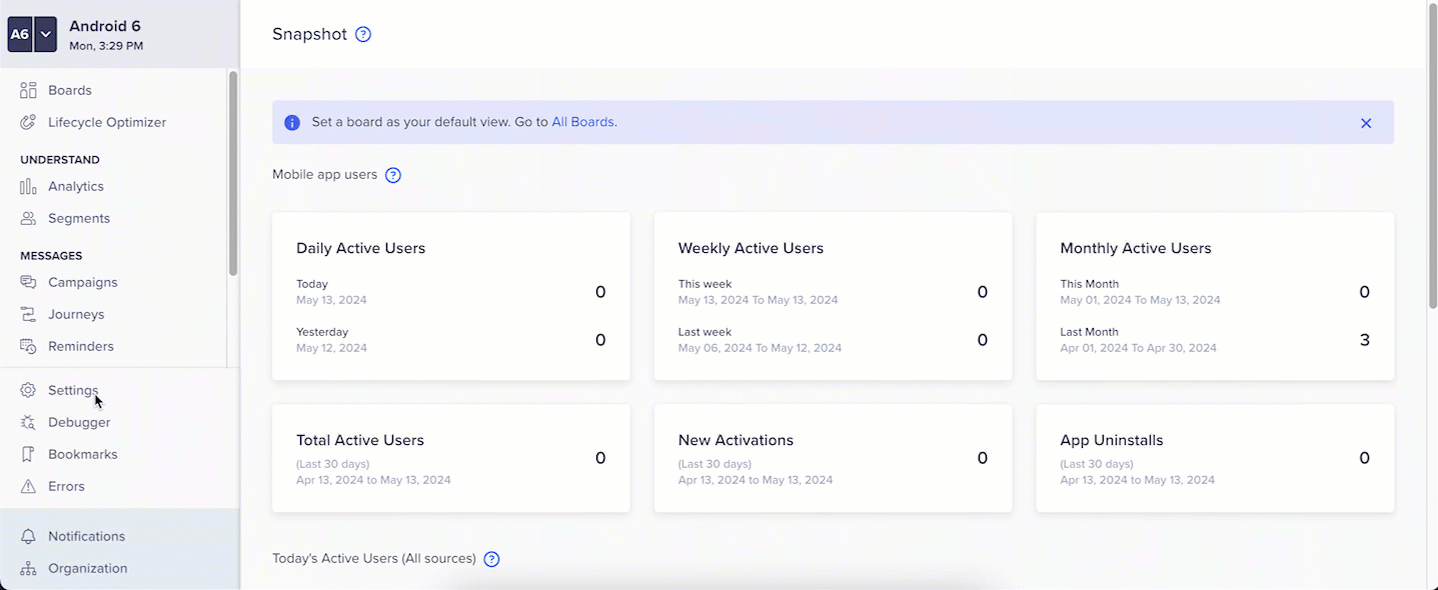
Navigating to Reminders Page
- Enter the following details:
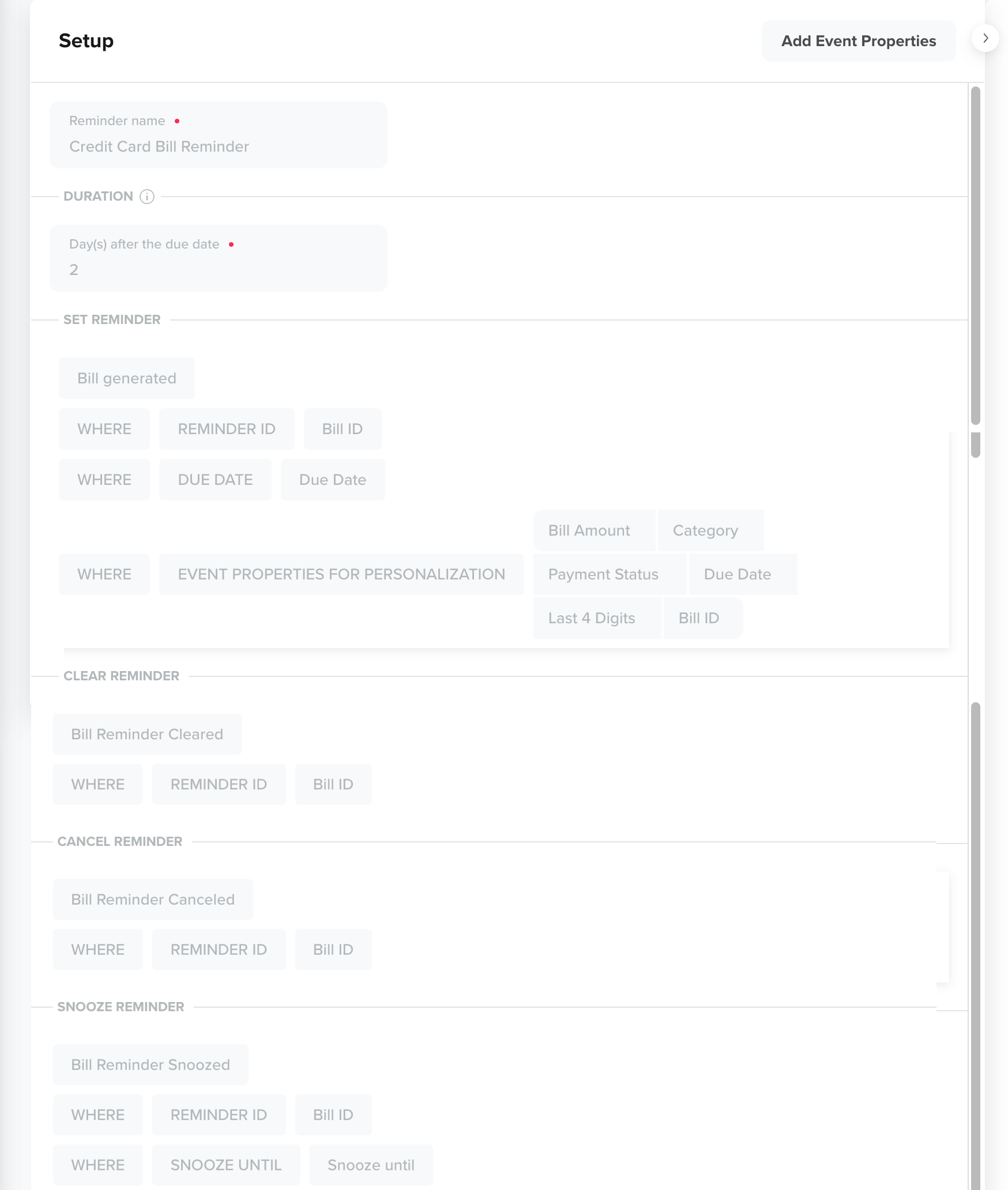
Set Up a Reminder
Field | Description |
|---|---|
Reminder Name | Enter the name to uniquely identify your reminder. |
Duration | Indicates the amount of time the reminder data is stored for each customer once the due date passes. |
Set Reminder | Define the event to qualify your customers for the reminder campaigns. For example, you want to set up a reminder to pay the electricity bill. In this case, |
Clear Reminder/Cancel Reminder | Refers to the action taken by a user or an administrator to deactivate or stop a scheduled reminder from being sent to a particular recipient. |
Snooze Reminder | If a customer receives a reminder about a task they need to complete but are currently occupied, they can choose to snooze the reminder for a certain duration (for example, 1 day). During this snooze period, the reminder will not be sent. |
After saving the reminder, you can update it to include additional event properties, allowing for greater flexibility in personalizing reminder messages.
Create Campaign using Reminders
Consider the same example where you want to remind your customers about their upcoming Credit Card bill due date. You can create a targeted campaign using reminders to automate and personalize notifications. By setting up the right triggers, scheduling messages, and selecting the appropriate channels, you can ensure timely and effective communication, improving customer engagement and reducing missed payments.
After setting up the reminder, you can create a campaign using reminders:
- From the Setup page, click Create Campaign. The Select the channels for your Reminder campaigns popup opens.
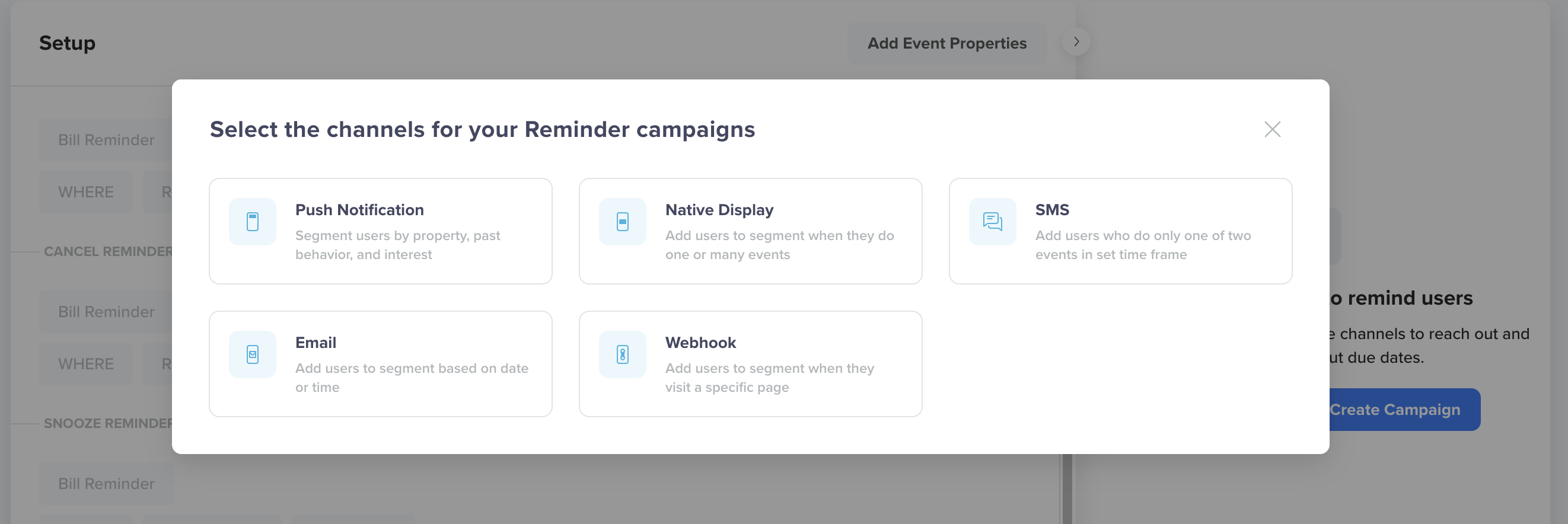
Select Channels for Reminder Campaign
- Select the channel for your Reminder campaign. For this example, we are selecting Push Notification. The New Push Notification Reminder popup opens.
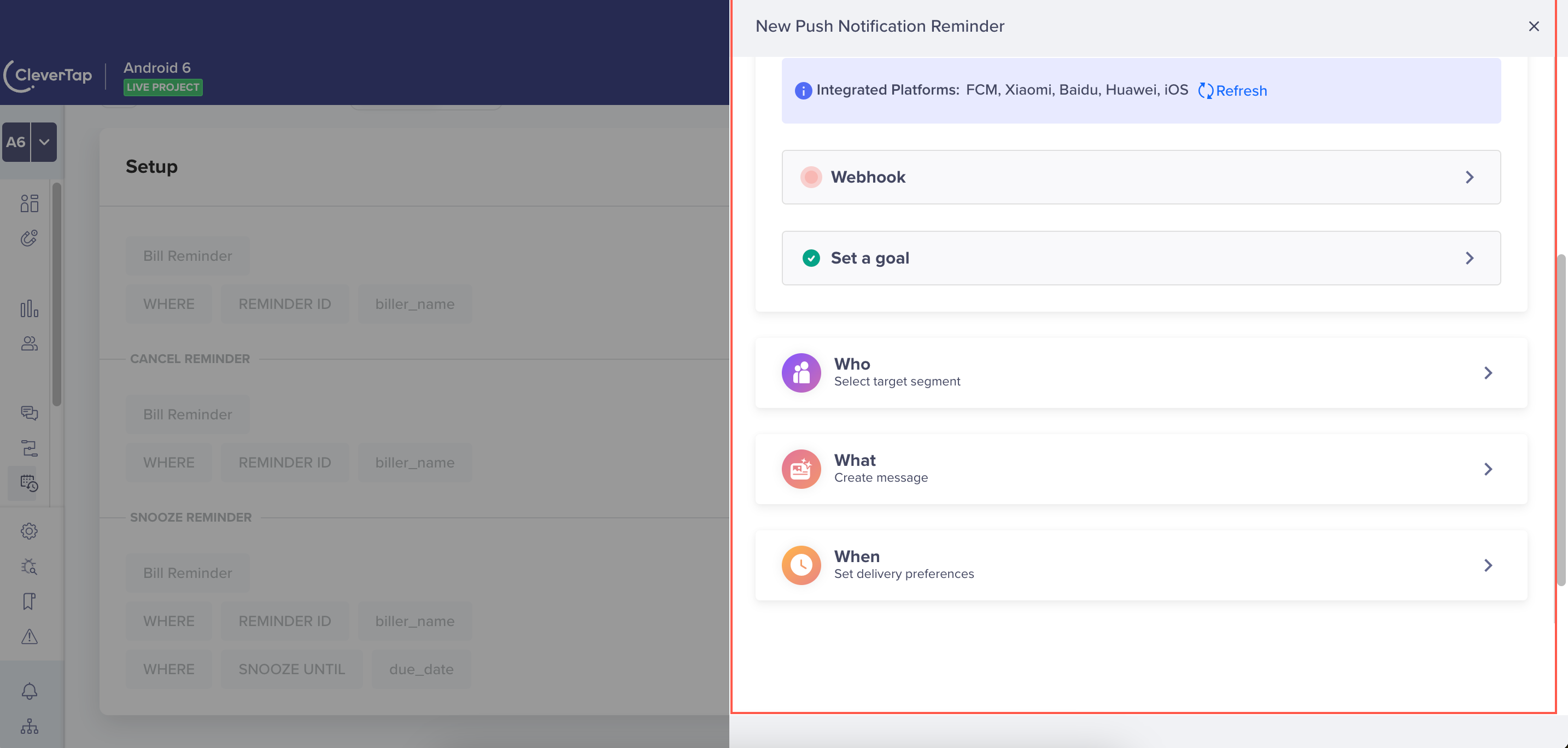
New Push Notification Reminder
- Define the Start here section for the campaign.
- Define the Who section. Here, you must define the duration for which engagements need to be sent. You can also filter your target audience.

Define Target Segment for Reminder Campaign
- Define the content for your Reminder campaigns.
- Define the Date and time to send the reminder campaign and also define the Delivery preferences.
Define Message for Reminder Campaigns
Consider the same example where you want to remind your customers about their upcoming Credit Card bill due date. When defining the target audience, we chose to send reminders two days before the due date, one reminder on the due date, and one reminder one day after the due date. Here, you can create different message variants for each day, that is, a different reminder message copy for -2 day, -1 day, due date, and +1 day. This customization allows for targeted messaging that aligns with the evolving context or objectives of each day.
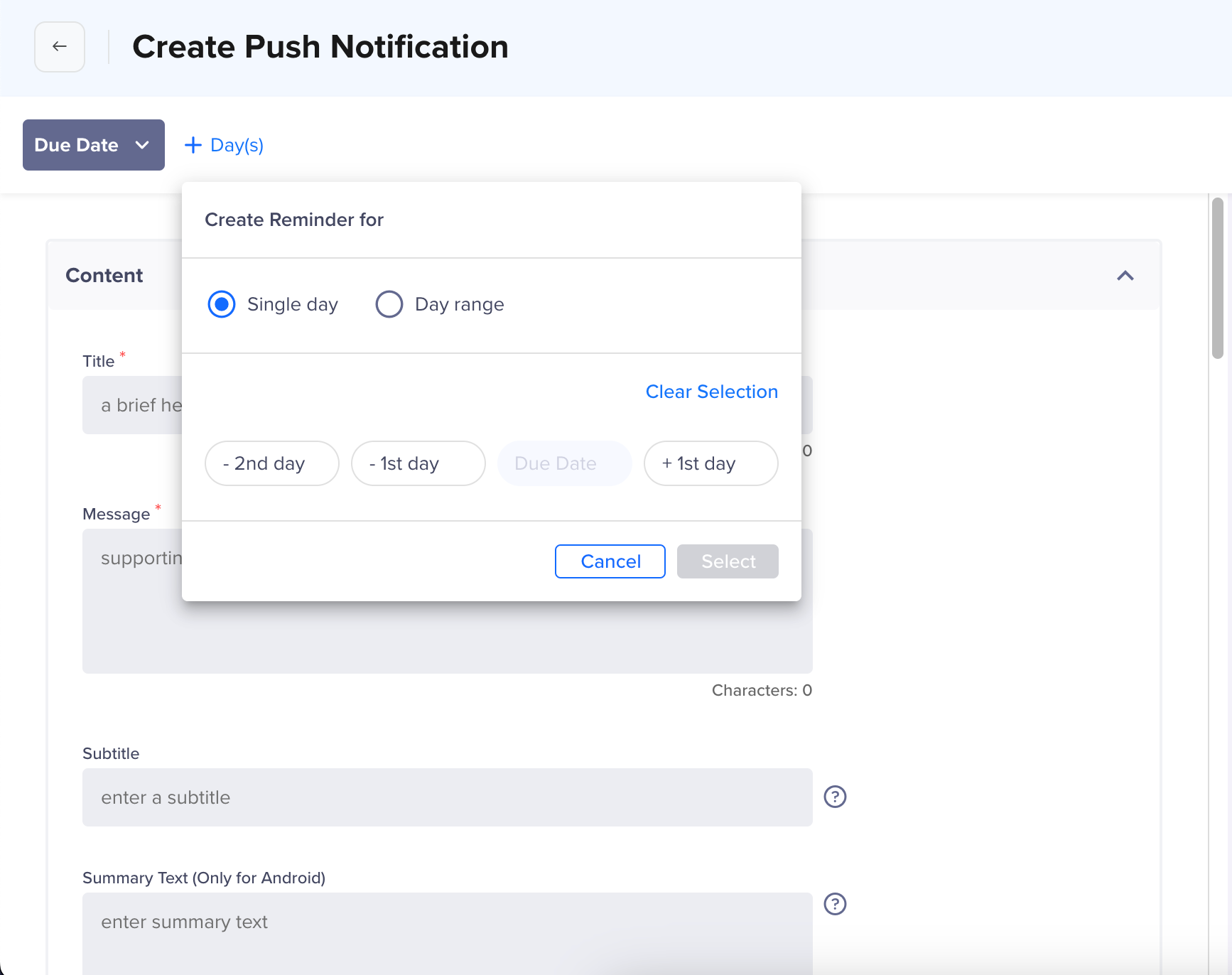
Create Reminder Message for Each Day
You also have the option to define a common message for multiple days. In our example, you may want to send the same reminder copy before the due date (in this case, -2 days to -1 day), a different copy for the reminder to be sent on the due date, and a different reminder message copy to be sent one day after the due date (+1 day).
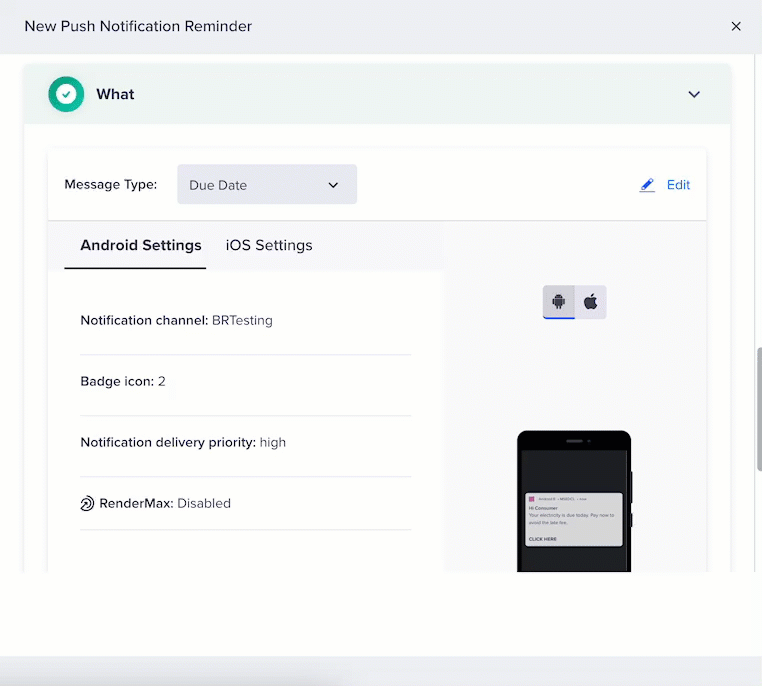
Define Common Reminder Copy For Date Range
You also have the option to copy a particular message and reuse it with minor or no changes, as shown in the following image:
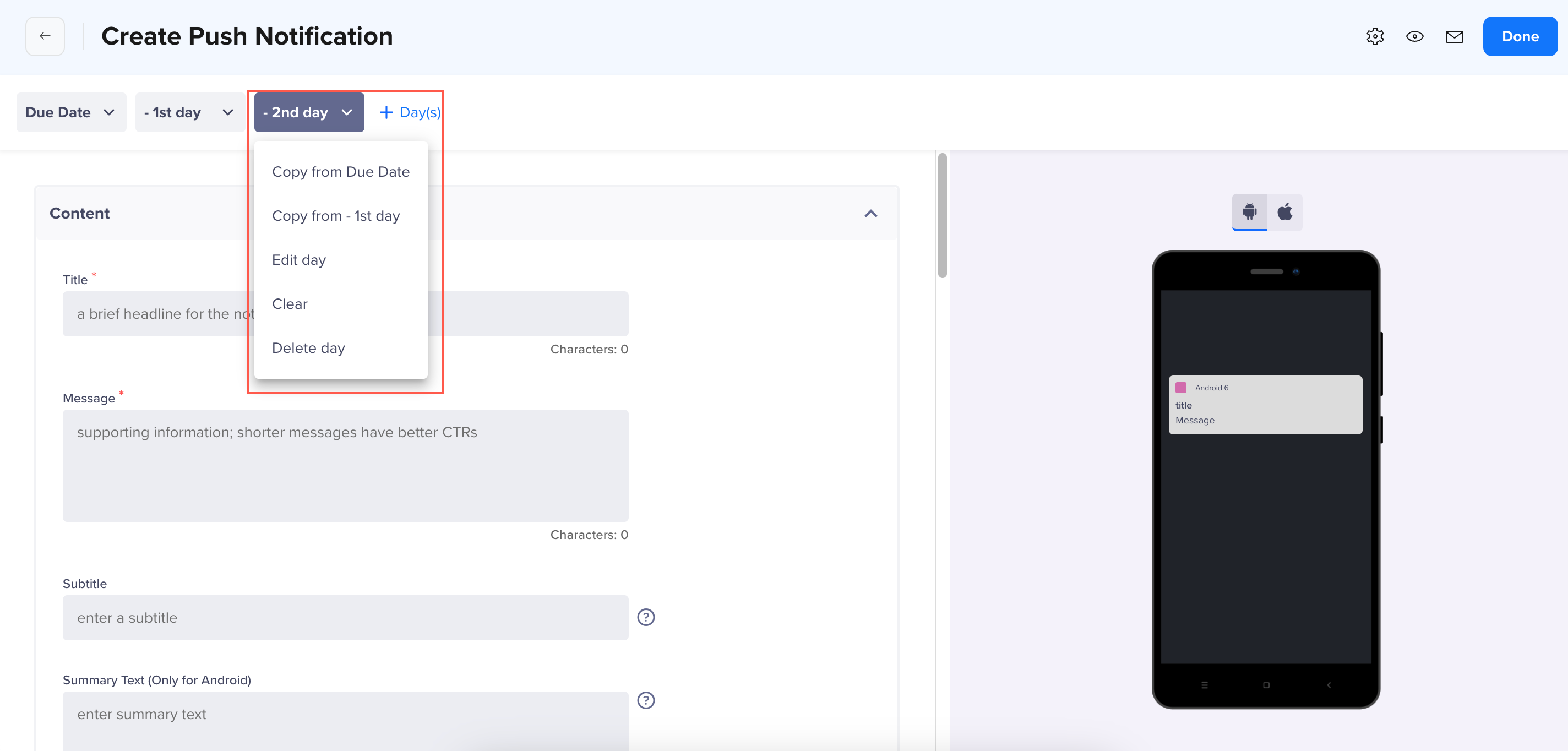
Copy Message from a Particular Variant
Define Schedule and Delivery Preferences
You can set up the When section to schedule the reminder campaign based on the following available options:
Data and Time
You can deliver the Reminder campaigns at the following times:
- Per the due date time: Selecting this option allows you to deliver the reminder campaign on and around the due date, ensuring timely delivery of notifications.
- Best time for every user: Selecting this option allows you to send the reminder campaign to every customer based on their most active time throughout the day. For more information, refer to Best Time Campaigns.
- A fixed time: Selecting this option allows you to send the reminder campaign to the customers at a fixed time during the day.
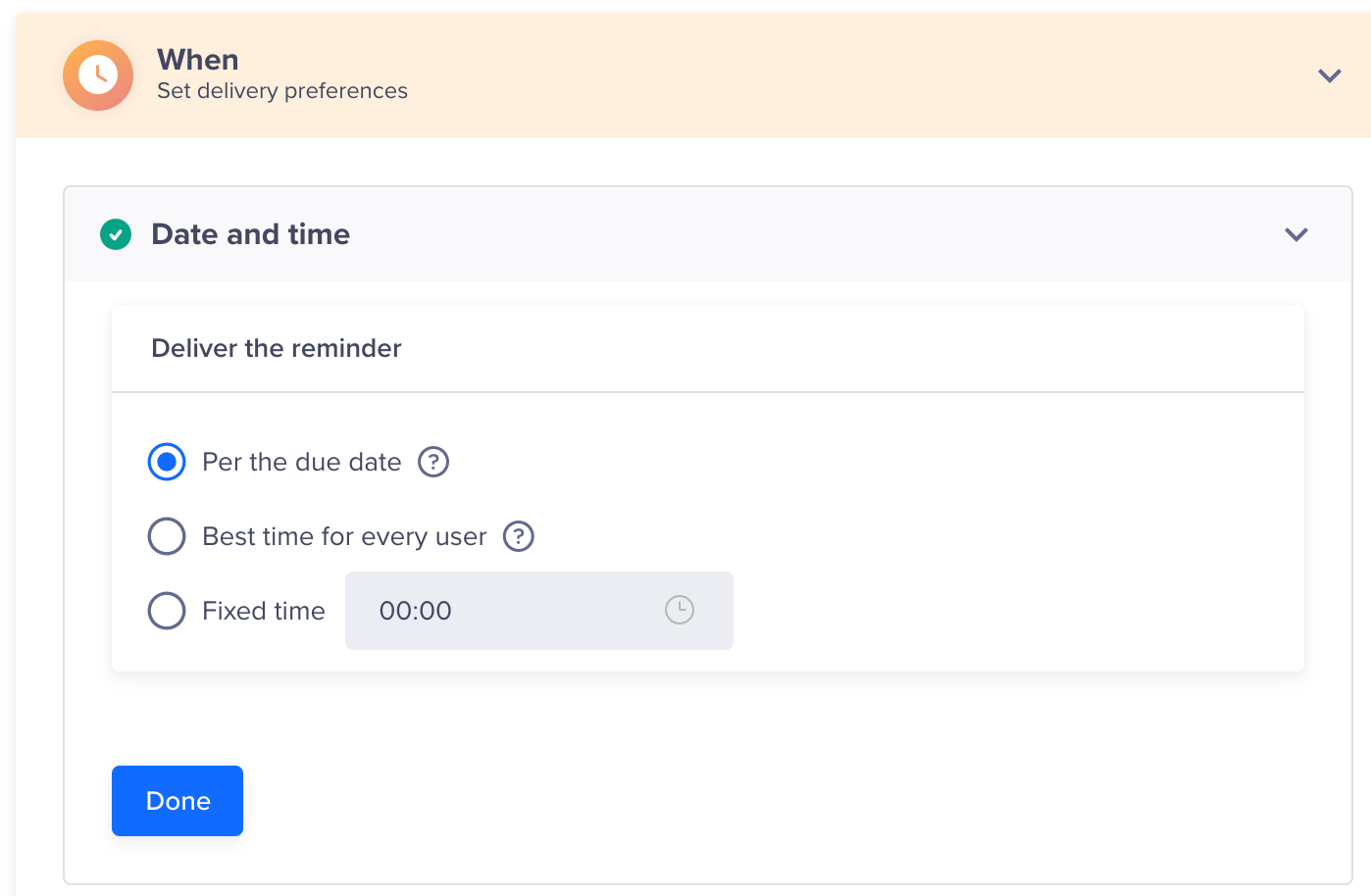
Select Delivery Option for Reminder Campaigns
Delivery Preferences
You can apply global campaign limits to determine how many notifications each app user receives per day. If you want to override these settings for an important campaign, you can select the Don’t apply global campaign limits to this campaign option.
You can also select the Advanced checkbox to specify Do Not Disturb (DND) hours during which notifications from this campaign are prevented from going out, either by discarding them or delaying delivery after DND hours, such as 9 PM to 9 AM.
Since past behavior campaigns can have scheduled times, you have the option to stop a campaign delivery after a certain cut-off time or even deliver at the specified time in the user’s timezone. For more information, refer to Delivery in User’s Timezone.
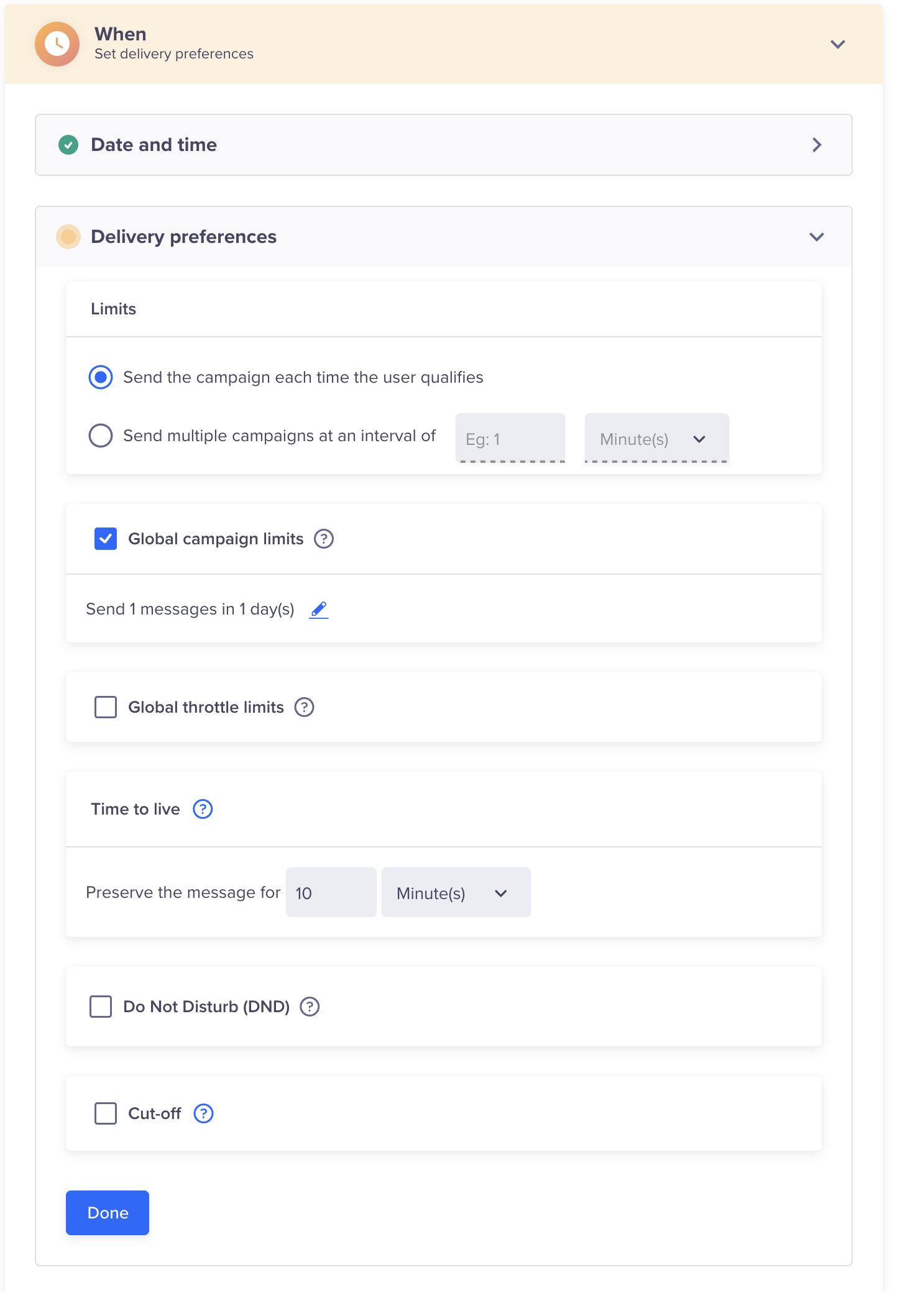
Set Up Delivery Preferences for Reminder Campaign
Recurring DayIf you specify a recurring day for a campaign such as the 7th of each month, then the campaign will start for the specified day and ignore the creation date. This is a precaution to avoid sending a campaign unintentionally on a prior date.
Time To Live
Time to Live is the persistence of a notification sent to an end user. Push services such as FCM, APNS, XPS, Baidu, and HMS manage Time to Live. They regulate the time the system monitors user device status to deliver a push notification. Whenever the user is online during the set TTL period, the notification is delivered. Any user not coming online will not receive the push notification, and no notifications are attempted after the TTL period is over.
Do Not Disturb (DND)
Select this option to avoid sending messages during certain times of the day. By default, DND limits are based on the user's time zone.
Cut-off
The campaign cut-off time ensures no notifications are sent after the specified time. Clevertap does not send notifications to the push services after the cut-off. This is useful if the campaign is time-sensitive and a later time makes the notification irrelevant.
Select Cut-off and specify the time to stop sending the notification when the target audience is large. This will cause a significant delay in processing the user queue, ensuring that no notification is sent after the set time.
Reminder Stats
Each reminder is evaluated based on various factors, including the number of messages sent, engagement rates, and user actions. Reminder Stats can be broadly categorized into the following sections:
Campaign ReportsTo generate reports for Reminders campaigns, contact your Customer Success Manager or the Support Team.
User Engagement and Insights
This section offers an in-depth analysis of customer interactions with reminder campaigns, enabling you to measure engagement, identify trends, and optimize future campaigns for better performance.

User Engagement Stats for Reminder
The key metrics analyzed include the following:
- Actions Trend
- Set: Total number of reminders sent to users. This indicates the campaign reach.
- Clear: Number of customers who manually dismissed or marked the reminder as completed. A high number suggests reminders are acknowledged but may also indicate your customers prefer fewer notifications.
- Cancel: Number of customers who opted out of receiving further reminders. A high cancellation rate may indicate irrelevance or excessive notifications.
- Snooze: Number of customers who postponed the reminder for a later time. This shows how many customers engage but prefer flexibility.
- Performance By Channels
- Channel Type: The messaging channel used to deliver the reminder, such as push notifications, email, SMS, or InApp messages. The effectiveness of each channel varies based on user preferences and engagement patterns.
- Number of Campaigns: The total campaigns executed through each channel. This helps analyze the distribution of reminders across different channels.
- Sent: The total number of reminders sent through a particular channel. A higher number indicates a broader reach.
- Impressions: The number of times a reminder was displayed to customers (applicable to certain channels such as InApp messages).
- Clicked: The number of customers who engaged with the reminder by clicking on it. A high click count suggests strong user interest and engagement.
Individual Campaign Performance
You can view the performance of each campaign by clicking it from the Performance By Channels section. This section offers a detailed breakdown of each reminder campaign's performance, enabling you to measure engagement and refine future campaigns for improved results. For more information, refer to the Campaign Stats document for the respective messaging channel.

Individual Reminder Campaign Performance
FAQs
This section covers FAQs related to the Reminders.
What value do CleverTap Reminders offer for my business?
CleverTap Reminders help reduce churn, boost conversions, and increase customer engagement by sending timely, automated nudges. This ensures users do not miss important actions, minimizes unnecessary notifications, and improves operational efficiency through smart automation.
Which channels are supported for sending Reminders?
You can deliver Reminder campaigns via Push Notifications, SMS, Email, WhatsApp, and Webhooks.
How do I create a Reminder campaign?
Set up predefined triggers to notify customers about key actions such as bill payments, subscription renewals, or special offers. Use Set Reminder and Clear Reminder events to qualify or disqualify customers based on their activity.
How early can I schedule a Reminder?
You can schedule Reminders from:
- 90 days before the action date
- 60 days after the action date.
For added flexibility, you can even schedule them up to 370 days in advance or 60 days post-deadline.
Is it possible to set up multi-day Reminders?
Yes. You can schedule multi-day, multi-channel reminders within a single campaign. For example, reminders sent “5 days before,” “on the day,” and “after a missed action.”
How does automatic Reminder cancellation work?
To cancel future notifications automatically, the Clear Reminder event must carry the same unique Reminder ID (for example, bill ID) used in the Set Reminder event. This ensures reminders stop once the action is completed.
Can Reminders be personalized for each customer?
Yes. You can tailor Reminder messages with personalized details such as customer names, due dates, product info, and past interactions for every reminder day, making messages more relevant and engaging.
How are Reminders different from regular campaigns?
Unlike standard campaigns, Reminders are proactive, automated, and intelligently responsive. They deliver multi-day, personalized nudges in a single campaign, automatically cancel notifications when actions are completed, and reduce the need for manual setup. Regular campaigns, on the other hand, require separate setups for each date and do not support automatic cancellations.
What makes CleverTap Reminders different from Journeys?
Reminders qualify customers for each event instance and support recurring, personalized multi-day nudges (for example, D-5, D-3, D-1). Journeys, on the other hand, qualify users only once per trigger and offer personalization within a 24-hour window. Additionally, Reminder campaigns allow edits and schedule changes even while running, whereas Journeys restrict content updates once live.
Updated 13 days ago
